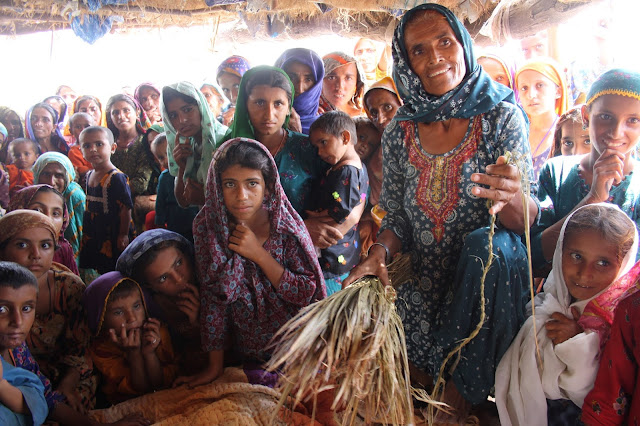Towards Universal Social Protection – the Story Thus Far
BlogPublished Date:
By Haris Gazdar
 |
| Women and girls in Qamber, Shadakot, north-west Sindh. Picture credit: Wikimedia Commons. This blog is based on a response by the author at the annual Sustainable Development Conference of the Sustainable Development Policy Institute on 14th December 2020. Question What major policy changes in existing national policies and programs you would like to see at federal and provincial government level to move towards universal social protection in Pakistan?
Answer We have the bare bones of a universal social protection system which was established over a decade ago in the form of the Benazir Income Support Programme. There are several important accomplishments to date, all of them achieved early on. And plenty of challenges. The main accomplishments were: • Targeting from a well-defined universe • Delinking social protection from employment • Increase in scale with respect to fiscal outlay • Women as primary beneficiaries • Key partnerships between databases (particularly NADRA) and payment agencies (banks/Telcos) In the initial period there was talk of the programme focusing on food insecurity, and the targeting mechanism did, indeed, help to identify the relatively food-insecure families. But this thematic focus, or for that matter any other specific thematic focus, never really became a benchmark of progress. The programme was far too engaged, perhaps for good reason, with achieving its own operational goals. The move to universal social protection will require several important changes which must leverage the successes achieved over a decade ago: • Articulation of key social protection objectives – in my opinion food security should receive priority, but also economic vulnerability • Re-establish a clearer linkage with livelihoods and/or absence of livelihood opportunities, but also a focus on a range of vulnerabilities such as different ability, old age • Dynamic social registry with a rights-based approach and self-targeting (with various mechanisms for verification and audit of course). Federal and provincial governments, and indeed local governments, have key roles and mandates in this regard. For all the media presence and slick imaging, the repackaging of BISP (into Ehsaas etc) conceals a cold hard fact: the core of social protection system, which is the unconditional cash transfer (UCT) to women in poor households has not been maintained and updated. The basic design requirement of renewing the targeting (or recertification) within 48 months of establishment has not be fulfilled – or around 2015. Five years on from that date, we have no clear indication of when the recertification (or the so-called National Socio-Economic Registry or NSER) will be carried out. Under our current system the federal government enjoys taxation powers across a range of relatively higher-yielding heads of tax, and their performance in tax collection has been poor. Provincial governments have performed better since the 7th National Finance Commission. But until there is a major change in the tax mandates, federal government will continue to have the fiscal resources for social protection. There is also a strong rationale for federal government lead in national redistributive transfers, and a whole range of untargeted subsidies are already routed through the federal tier. Over the longer-term, the future of social protection is closely tied up with tax performance and reform. More on that in a bit. Moreover, federal government also controls major official databases such as NADRA which have become indispensable – for good reason or bad – for the administration of social protection interventions. But provincial governments and their local government partners (let’s be clear that constitutionally local government is a provincial subject), actually have presence on the ground, and have mandates in a range of areas where the next generation of social protection programming – food security, labour, agricultural workers, health, disaster management (partially), protection of the differently abled, education etc – will arise. ‘Next generation’ in the sense of going beyond an unconditional cash transfer (UCT). Provinces need to build strong and dynamic social registries and federal government systems need to extend active cooperation and support in this regard. This is because under our constitutional system a dynamic social registry, which has close operational links with line departments such as labour, differently abled persons’ empowerment, health, population welfare, local government, agriculture, food etc. is only possible at the provincial tier. The type of political reforms that will lead to these changes are similar in scale, or even the unfinished businesses of, reforms like the 18th amendment involving:
|